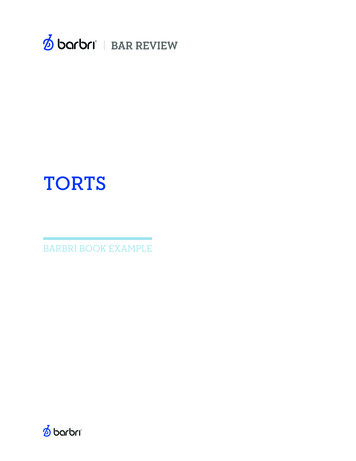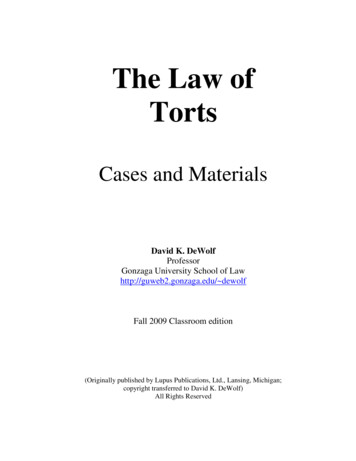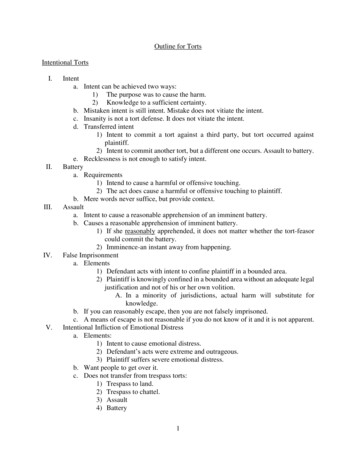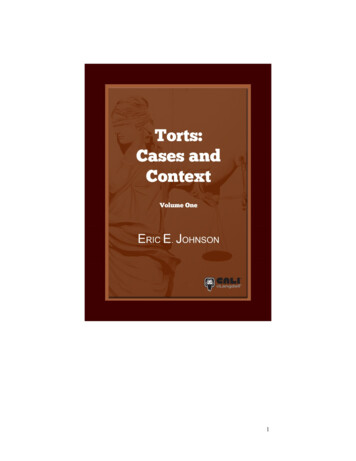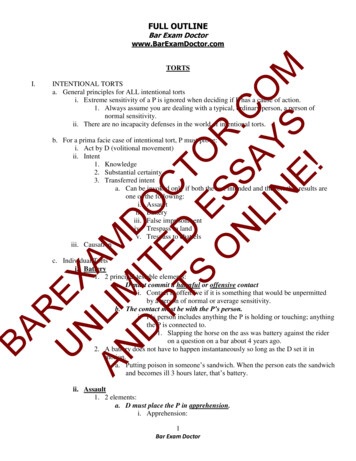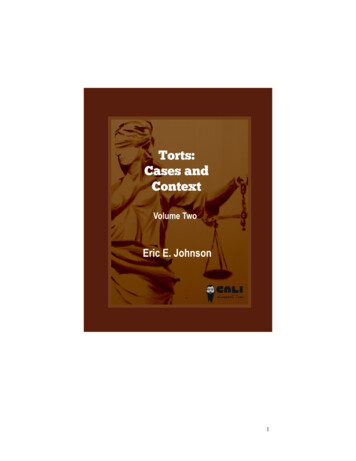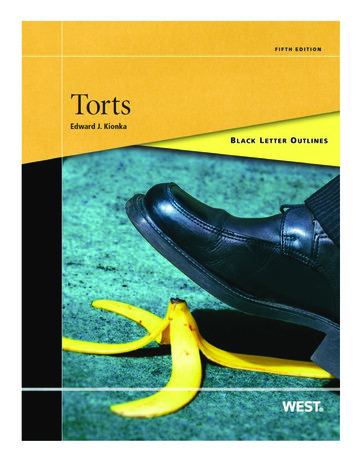
Transcription
Torts
West’s Law SchoolAdvisory BoardJESSE H. CHOPERProfessor of Law and Dean Emeritus,University of California, BerkeleyJOSHUA DRESSLERProfessor of Law, Michael E. Moritz College of Law,The Ohio State UniversityYALE KAMISARProfessor of Law Emeritus, University of San DiegoProfessor of Law Emeritus, University of MichiganMARY KAY KANEProfessor of Law, Chancellor and Dean Emeritus,University of California,Hastings College of the LawLARRY D. KRAMERPresident, William and Flora Hewlett FoundationJONATHAN R. MACEYProfessor of Law, Yale Law SchoolARTHUR R. MILLERUniversity Professor, New York UniversityFormerly Bruce Bromley Professor of Law, Harvard UniversityGRANT S. NELSONProfessor of Law, Pepperdine UniversityProfessor of Law Emeritus, University of California, Los AngelesA. BENJAMIN SPENCERProfessor of Law,Washington & Lee University School of LawJAMES J. WHITEProfessor of Law, University of Michigan
BLACKLETTEROUTLINESTortsby Edward J. KionkaProfessor of Law EmeritusSouthern Illinois University at CarbondaleFIFTHMat #41150408EDITION
This publication was created to provide you with accurate and authoritative information concerningthe subject matter covered; however, this publication was not necessarily prepared by personslicensed to practice law in a particular jurisdiction. The publisher is not engaged in rendering legal orother professional advice and this publication is not a substitute for the advice of an attorney. If yourequire legal or other expert advice, you should seek the services of a competent attorney or otherprofessional.Nothing contained herein is intended or written for the purpose of 1) avoiding penalties imposedunder the federal Internal Revenue Code, or 2) promoting, marketing or recommending to anotherparty any transaction or matter addressed herein.Black Letter Series is a trademark registered in the U.S. Patent and Trademark Office.COPYRIGHT 1988, 1993 WEST PUBLISHING CO. 2002, 2006 West, a Thomson business 2013 LEG, Inc. d/b/a West Academic Publishing610 Opperman DriveSt. Paul, MN 551231–800 313 9378West, West Academic Publishing, and West Academic are trademarks of West Publishing Corporation, used under license.Printed in the United States of AmericaISBN: 978 0 314 27552 3
vPrefaceThis “Black Letter” is designed to help a law student recognize andunderstand the basic principles and issues of law covered in a law school course.It can be used both as a study aid when preparing for classes and as a review ofthe subject matter when studying for an examination.Each “Black Letter” is written by experienced law school teachers who arerecognized national authorities on the subject covered.The law is succinctly stated by the author of this ″Black Letter.″ In addition,the exceptions to the rules are stated in the text. The rules and exceptions havepurposely been condensed to facilitate quick review and easy recollection. For anin-depth study of a point of law, citations to major student texts are given. Inaddition, a Text Correlation Chart provides a convenient means of relatingmaterial contained in the “Black Letter” to appropriate sections of the casebookthe student is using in his or her law school course.If the subject covered by this text is a code or code-related course, the codesection or rule is set forth and discussed wherever applicable.FORMATThe format of this “Black Letter” is specially designed for review. (1) Text.First, it is recommended that the entire text be studied, and, if deemed necessary,supplemented by the student texts cited. (2) Capsule Summary. The CapsuleSummary is an abbreviated review of the subject matter which can be used bothbefore and after studying the main body of the text. The headings in the Capsule
viPREFACESummary follow the main text of the ″Black Letter.″ (3) Table of Contents. TheTable of Contents is in outline form to help you organize the details of the subjectand the Summary of Contents gives you a final overview of the materials. (4)Practice Examination. The Practice Examination in Appendix B gives you theopportunity of testing yourself with the type of question asked on an exam, andcomparing your answer with a model answer.In addition, a number of other features are included to help you understandthe subject matter and prepare for examinations:Short Questions and Answers: This feature is designed to help you spot andrecognize issues in the examination. We feel that issue recognition is a majoringredient in successfully writing an examination.Perspective: In this feature, the authors discuss their approach to the topic,the approach used in preparing the materials, and any tips on studying for andwriting examinations.Analysis: This feature, at the beginning of each section, is designed to give aquick summary of a particular section to help you recall the subject matter and tohelp you determine which areas need the most extensive review.Examples: This feature is designed to illustrate, through fact situations, thelaw just stated. This, we believe, should help you analytically approach a questionon the examination.Glossary: This feature is designed to refamiliarize you with the meaning ofa particular legal term. We believe that the recognition of words of art used in anexamination helps you to better analyze the question. In addition, when writingan examination you should know the precise definition of a word of art youintend to use.We believe that the materials in this “Black Letter” will facilitate your studyof a law school course and assure success in writing examinations not only for thecourse but for the bar examination. We wish you success.THE PUBLISHER
Summary of ContentsCAPSULE SUMMARY OF TORT LAW . . . . . . . . . . . . . . . . . . . . . . . . . . . . . . . .1PERSPECTIVE . . . . . . . . . . . . . . . . . . . . . . . . . . . . . . . . . . . . . . . . . . . . . . . . . . 115PART ONE: INTRODUCTIONI.General Considerations . . . . . . . . . . . . . . . . . . . . . . . . . . . . . . . . . 127PART TWO: INTENTIONAL TORTSII.III.Liability Rules for Intentional Torts . . . . . . . . . . . . . . . . . . . . . . . . 142Defenses to Liability for Intentional Torts: Privileges . . . . . . . . . . 159PART THREE: NEGLIGENCEIV.V.Negligence Liability Rules . . . . . . . . . . . . . . . . . . . . . . . . . . . . . . . 180Defenses to Negligence and Other Liability . . . . . . . . . . . . . . . . . . 210PART FOUR: CAUSATIONVI.Causation . . . . . . . . . . . . . . . . . . . . . . . . . . . . . . . . . . . . . . . . . . . . 235PART FIVE: SPECIAL LIABILITY RULES FORPARTICULAR ACTIVITIESVII. Overview . . . . . . . . . . . . . . . . . . . . . . . . . . . . . . . . . . . . . . . .VIII. Owners and Occupiers of Land . . . . . . . . . . . . . . . . . . . . . .IX. Products Liability . . . . . . . . . . . . . . . . . . . . . . . . . . . . . . . . .X. Vicarious Liability . . . . . . . . . . . . . . . . . . . . . . . . . . . . . . . . .XI. Employer’s Liability to Employees . . . . . . . . . . . . . . . . . . . .XII. Automobiles . . . . . . . . . . . . . . . . . . . . . . . . . . . . . . . . . . . . .XIII. Medical and Other Professional Negligence (“Malpractice”)XIV. Nuisance . . . . . . . . . . . . . . . . . . . . . . . . . . . . . . . . . . . . . . . .XV. Negligent Infliction of Emotional Distress . . . . . . . . . . . . . .XVI. Prenatal Harm . . . . . . . . . . . . . . . . . . . . . . . . . . . . . . . . . . . .XVII. Alcoholic Beverages . . . . . . . . . . . . . . . . . . . . . . . . . . . . . . .XVIII. Interference With Federal Constitutional Rights . . . . . . . . .XIX. Activities Causing Only Economic Harm . . . . . . . . . . . . . . .260260278294302305307312317321323325326
viiiSUMMARY OF CONTENTSPART SIX: STRICT LIABILITYXX.Strict Liability . . . . . . . . . . . . . . . . . . . . . . . . . . . . . . . . . . . . . . . . . 331PART SEVEN: DAMAGES FOR PHYSICAL HARMXXI. Damages for Physical Harm . . . . . . . . . . . . . . . . . . . . . . . . . . . . . . 342PART EIGHT: SURVIVAL AND WRONGFUL DEATHXXII. Survival and Wrongful Death . . . . . . . . . . . . . . . . . . . . . . . . . . . . . 367PART NINE: NON–PHYSICAL HARM:MISREPRESENTATION, DEFAMATION, AND PRIVACYXXIII. Misrepresentation . . . . . . . . . . . . . . . . . . . . . . . . . . . . . . . . . . . . . . 380XXIV. Defamation . . . . . . . . . . . . . . . . . . . . . . . . . . . . . . . . . . . . . . . . . . . 388XXV. Privacy . . . . . . . . . . . . . . . . . . . . . . . . . . . . . . . . . . . . . . . . . . . . . . 406APPENDICESApp.A.B.C.D.E.F.G.Answers to Review Questions . . . . . . . . . . . . . . . . . . . . . . .Practice Examination . . . . . . . . . . . . . . . . . . . . . . . . . . . . . .A Suggested Analysis of the Practice Examination QuestionsGlossary . . . . . . . . . . . . . . . . . . . . . . . . . . . . . . . . . . . . . . .Text Correlation Chart . . . . . . . . . . . . . . . . . . . . . . . . . . . . .Table of Cases . . . . . . . . . . . . . . . . . . . . . . . . . . . . . . . . . . .Index . . . . . . . . . . . . . . . . . . . . . . . . . . . . . . . . . . . . . . . . .413435439451465475477
Table of ContentsCAPSULE SUMMARY OF TORT LAW . . . . . . . . . . . . . . . . . . . . . . . . . . . . . . . .1PERSPECTIVE . . . . . . . . . . . . . . . . . . . . . . . . . . . . . . . . . . . . . . . . . . . . . . . . . . 115PART ONE: INTRODUCTIONI.General Considerations . . . . . . . . . . . . . . . . . . . . . . .A. Overview of Tort Law . . . . . . . . . . . . . . . . . . . . . . .B. The Definitional Dilemma . . . . . . . . . . . . . . . . . . . .1. What Is a Tort? . . . . . . . . . . . . . . . . . . . . . . . . .2. No General Principle of Tort Liability . . . . . . . .3. Definition . . . . . . . . . . . . . . . . . . . . . . . . . . . . .4. Fault . . . . . . . . . . . . . . . . . . . . . . . . . . . . . . . . .C. Bases, Purposes and Functions of Tort Law . . . . . . .1. Where Does Tort Law Come From? . . . . . . . . . .a. Morality or Corrective Justice . . . . . . . . . . .b. Social Utility or Policy . . . . . . . . . . . . . . . . .c. Process or Procedural Considerations . . . . . .d. Formal Reasoning . . . . . . . . . . . . . . . . . . . .2. Functions or Goals of Tort Law . . . . . . . . . . . . .a. Compensation . . . . . . . . . . . . . . . . . . . . . . .b. Justice and the Promotion of Desired Policiesc. Deterrence . . . . . . . . . . . . . . . . . . . . . . . . . .d. Other Functions of Tort Law . . . . . . . . . . . .D. Sources of Tort Law . . . . . . . . . . . . . . . . . . . . . . . . .E. Historical Development of Tort Law . . . . . . . . . . . .1. Evolution of Tort Remedies . . . . . . . . . . . . . . . .2. Evolution of Theories of Liability . . . . . . . . . . . .F. The Roles of Judges and Juries . . . . . . . . . . . . . . . .G. Tortious Conduct . . . . . . . . . . . . . . . . . . . . . . . . . . .H. Tort Duties and Contractual Duties . . . . . . . . . . . . .I. Tort Law and Criminal Law . . . . . . . . . . . . . . . . . .J. Terms . . . . . . . . . . . . . . . . . . . . . . . . . . . . . . . . . . .1. Injury . . . . . . . . . . . . . . . . . . . . . . . . . . . . . . . .2. Harm . . . . . . . . . . . . . . . . . . . . . . . . . . . . . . . .3. Physical Harm . . . . . . . . . . . . . . . . . . . . . . . . .4. Conduct . . . . . . . . . . . . . . . . . . . . . . . . . . . . . .5. Subject to Liability . . . . . . . . . . . . . . . . . . . . . . 29129129129129131132133134134134134134134135135
xTABLE OF CONTENTS6.7.Had Reason to Know . . . . . . . . . . . . . . . . . . . . . . . . . . . . . . 135Should Have Known . . . . . . . . . . . . . . . . . . . . . . . . . . . . . . . 135PART TWO: INTENTIONAL TORTSII.Liability Rules for Intentional Torts . . . . . . . . . . . . . . . . . . . . . . .A. Intent . . . . . . . . . . . . . . . . . . . . . . . . . . . . . . . . . . . . . . . . . . . .1. Rule . . . . . . . . . . . . . . . . . . . . . . . . . . . . . . . . . . . . . . . . . .2. Proof of Intent . . . . . . . . . . . . . . . . . . . . . . . . . . . . . . . . . . .3. Intent Distinguished From Motive . . . . . . . . . . . . . . . . . . . .4. Intentional Conduct Distinguished From Negligent orReckless Conduct . . . . . . . . . . . . . . . . . . . . . . . . . . . . . . . .5. Children . . . . . . . . . . . . . . . . . . . . . . . . . . . . . . . . . . . . . . .6. Mentally Incompetent Persons . . . . . . . . . . . . . . . . . . . . . . .7. Transferred Intent . . . . . . . . . . . . . . . . . . . . . . . . . . . . . . . .8. Scope of Liability (Proximate Cause): The Extended LiabilityPrinciple . . . . . . . . . . . . . . . . . . . . . . . . . . . . . . . . . . . . . . .B. Battery . . . . . . . . . . . . . . . . . . . . . . . . . . . . . . . . . . . . . . . . . . .1. Rule . . . . . . . . . . . . . . . . . . . . . . . . . . . . . . . . . . . . . . . . . .2. Intent Required . . . . . . . . . . . . . . . . . . . . . . . . . . . . . . . . . .3. P’s Person . . . . . . . . . . . . . . . . . . . . . . . . . . . . . . . . . . . . . .4. P’s Awareness . . . . . . . . . . . . . . . . . . . . . . . . . . . . . . . . . . .5. No Harm Intended? . . . . . . . . . . . . . . . . . . . . . . . . . . . . . .6. Harmful Contact . . . . . . . . . . . . . . . . . . . . . . . . . . . . . . . . .7. Offensive Contact . . . . . . . . . . . . . . . . . . . . . . . . . . . . . . . .8. Consent . . . . . . . . . . . . . . . . . . . . . . . . . . . . . . . . . . . . . . .C. Assault . . . . . . . . . . . . . . . . . . . . . .
Table of Contents is in outline form to help you organize the details of the subject and the Summary of Contents gives you a final overview of the materials. (4) Practice Examination. The Practice Examination in Appendix B gives you the opportunity of testing yourself with the type of File Size: 588KBPage Count: 152
